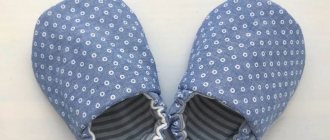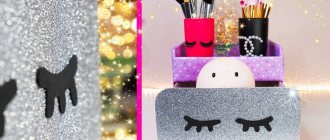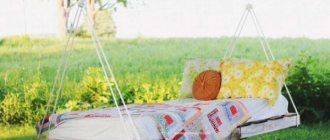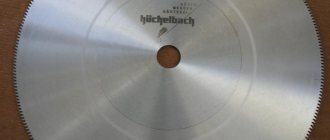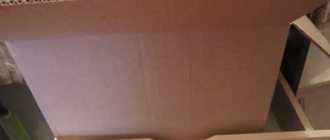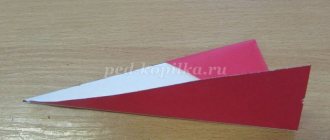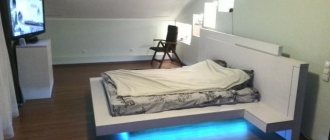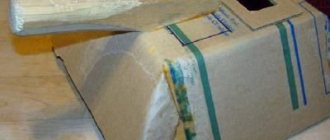Many housewives store their main kitchen tools - knives - in special stands or countertops, which is not always practical. Specifically, in order to make work in the kitchen easier and faster, we came up with such an interesting and extraordinary device as a magnetic knife holder, which can easily be mounted on the wall next to the workplace. This “technology” is very popular and is sold everywhere.
Magnet for knives on the wall.
Stand material
Knife stands are made from a wide variety of materials: glass, iron, rubber, but the most common are wood and plastic. Each of them has its own advantages and disadvantages. The choice depends entirely on financial capabilities, the interior of the kitchen and the knives themselves.
Tree
Wooden stands are a classic option, found in two out of three kitchens. The material is ergonomic, environmentally friendly, compact, and will fit into any type of interior. These stands can accommodate a small number of knives – up to six pieces. It is convenient to store the most popular, working knives in them, which are used most often, so they will be at hand. As a rule, their design is such that the plane is located at an angle, this makes it possible to conveniently pull them out and put them back.
But wood has a significant drawback - it swells under the influence of falling drops of water. Accordingly, this also harms the blades. Another disadvantage of such stands is the inability to thoroughly clean the holes in the stands due to their narrowness. It is for this reason that bacteria can accumulate there. And also in such sets it is not visible which copy is located where, since they all have the same handles.
Plastic
Ceramic knives are usually stored in a plastic or polypropylene stand. To prevent their fragile blades from being injured, they should not be stored together with steel or other devices. A separate stand is required, plastic is best. In such models, silicone separators are most often used, since they do not harm the ceramic blades.
Classification
As for classification, magnetic holders do not have any varieties. Conventionally, they can be divided by length and material of manufacture.
By lenght
Knife holders purchased in company stores cannot exceed a certain length (from 300 to 600 mm). There are also fakes on the market. If we talk about local or Chinese copies, they have different sizes. You should keep this fact in mind when purchasing such a useful product.
This is interesting: Rubber base for gel polish
By material
In modern production, the following materials are used for the manufacture of magnetic holders:
- Metal – a product made from this material is considered to be of the highest quality. This is due to the fact that metal has a stronger magnetization and thereby helps to hold heavier kitchen items, for example, a small hatchet.
- Plastic - this holder is short-lived, so it will have to be replaced more often with a new one.
- Wood – Magnetic boards made from wood have always been considered attractive as well as environmentally friendly. But, despite these properties, such products have a weak force of attraction; they will not be able to hold objects heavier than kitchen knives.
Tips for choosing
When choosing knife holders, you should always pay attention to the main characteristics. Quality guarantee can only be provided in stores that have special certificates
If the purchase is not made in branded places, you need to pay attention to:
- product quality - there should be no backlash or creaks in the assembly;
- the strength of the magnets - the knives should hold normally, not weakly and not too tightly;
- length - for a branded product it cannot exceed 60 centimeters.
It is also worth remembering that magnetic strips for kitchen knives from well-known manufacturers are made from materials that are safe for health. This is confirmed by the presence of quality certificates provided in company stores. The most popular manufacturers are:
- Fissler;
- Hatamoto Japan;
- Nadoba;
- BergHOFF;
- Regent;
- WUESTHOF;
- Woodinhome.
Nadoba
BergHOFF
Regent
Woodinhome
Final works
Once the glue has dried well, you can remove the masking tape from the magnets. However, keep in mind that it will take longer for the glue to completely harden. Therefore, let the product dry overnight before you hang the knives on the holder.
This idea for storing kitchen knives is much more interesting than those boring plastic versions you can buy at the store. You can also choose a stain that matches other finishes in your kitchen. You can also easily paint the board any color you want.
This holder has a rectangular shape, but you can come up with your own version, for example, in the shape of a fish. You can also adjust the dimensions and make the knife holder longer or shorter depending on how many knives you have and the available kitchen wall space.
Found a violation? Report content
Key holder with magnet and light
I like to do a lot of things myself and am constantly looking for various interesting master classes on the Internet. But there was one thing I was always missing due to my carelessness - a key holder. With it, I would always remember where my keys are, and not waste precious time looking for them: sometimes in the morning I spend 10 minutes trying to dig them out among other things.
I decided to make one myself, and one that would be easy to make, but the product itself would be unusual—too banal for me to buy. My choice fell on the option with a magnet and backlight.
Now I’ll tell you what materials I needed.
- Acrylic and MDF boards of irregular shape.
- Aerosol paint of any color.
- Black or any other paint - it depends on your taste.
- Screws and tools for woodworking.
- Three LEDs of any color.
- Three neodymium magnets.
- Three rheostats at 220 Ohm.
- An old mobile USB charging cable, the end of which has been cut off.
Step 1. Preparing for assembly
- Sand the surface of the MDF board using sandpaper.
- Make a cut to secure the acrylic sheet horizontally.
- Attach three neodymium magnets to the bottom of the acrylic sheet.
I didn’t need a lot of materials to make the key holder
Step 2. Connect acrylic sheet and MDF
- Drill two small holes in the acrylic sheet where the insert will be in the MDF board.
- Make three holes, the size of which is 0.5 mm each. LEDs will be placed in these holes at the back of the MDF board.
- Apply some wood glue inside the MDF board and insert the acrylic sheet.
- Tighten the two small screws on the back of the MDF board to secure it tightly.
Connecting two different materials requires glue and screws.
Step 3. Decoration
I decorated this key holder with several triangles and circles made from balsa wood. I subsequently attached them to an MDF board.
Step 4: Connecting the LEDs
- Insert three LEDs behind the MDF board with all their wires pointing down.
- Solder a wire connecting all the wires brought out from the light bulbs.
- Attach three 220 Ohm rheostats to the positive of each LED.
- Solder another wire connecting all the top wires to the rheostats.
- Connect the red wire from the USB cable to the wire with rheostats soldered at the top, and the black wire from the USB cable to the bottom common wire.
You need to understand exactly how to connect LEDs
Step 5: Protect the Wiring
- Cover the LEDs with insulating tape.
- Secure the loose USB cable to the MDF board with a stapler or glue gun.
- Attach some legs behind the MDF board to protect the wiring while attaching to the wall.
Installing wiring requires some technical knowledge
Step 6: Installation
After the entire procedure, all that remains is to attach the key holder to the wall. You can screw it on, or you can use double-sided tape - whichever is preferable to you.
Now you can attach the keys to the neodymium magnets located at the bottom of the acrylic sheet. They won't fall - the magnets are powerful enough to hold them.
In general, I have been using this holder for a long time, and it only makes me happy. It was easy to make, and the benefits it brings are simply countless.
This is the holder I ended up with:
How to mount it straight to the wall
In order to properly hang the magnetic knife holder on the wall, you need to make preliminary marks evenly and accurately. To do this, you can use a regular or laser level, which will allow you to outline the horizontal placement. The distance between the magnet mounts is measured and the corresponding value is transferred to the wall.
The number of fasteners depends on the type and size of the holder. The most common design has two fasteners. They can be looped, located along the top of the bar, or hidden.
Very often, a magnetic holder is hung on a tile, since it is the tile that is used to decorate the work wall in the kitchen. Fastening is done using double-sided tape or using dowel nails. Usually the set of holders includes dowels and screws.
In order to securely and without destruction attach the magnet to the tile with dowel nails, you must be careful in your work. To do this, drilling is carried out in two stages:
- At the first stage, it is better to use a drill or screwdriver with a ceramic pen of the required diameter to drill the tiles.
- In the second stage, a hammer drill is used to make a hole in the wall itself.
A dowel is inserted into the finished hole, into which a nail is screwed or hammered.
Magnetic knife holders: how to choose and attach?
join the discussion
Share with your friends
Magnetic knife holders are a great alternative to tabletop holders and stands. They fit perfectly into the kitchen decor without disturbing the interior composition as a whole.
This is interesting: What can you eat for breakfast?
Fixing the board
The board is ready, all that remains is to fix it on the wall. To do this, we use hardware - we make holes in the wall, screw them in, and then hang the board behind them - for this we made special “notches” on the back side. Before screwing in hardware, make sure that there is no wiring in this section of the wall. Using a building level, check that the fasteners are at the same level.
Trying to attach a board to the wall in the kitchen
All is ready! We try to attach the knives - they hold perfectly. Remember that on one side we have more magnets, so it’s worth placing larger and heavier knives on it.
This is what the finished hanging board looks like, on which we have already attached the knives. The knife looks very nice
We are sure that such a magnetic board for knives is much better than a regular store-bought one, because it “has a soul” - it really pleases the eye when you look at what you have made with your own hands! Moreover, such a board can be made in just a few hours; no special knowledge or skills are required, so it’s definitely worth a try. We are sure that it will fit perfectly into the interior of your kitchen - natural wood always looks good.
How to make a knife stand with your own hands
Of course, you can spend a lot of money, turn to a specialist and get a chic knife stand for your kitchen. You can choose a suitable product in any household goods store - the range today is simply huge. But creative people will be much more impressed by a DIY knife stand, which can become a bright accent in the interior. It’s not difficult to make, the main thing is to stock up on the necessary materials and strictly follow the instructions.
Wooden with holes
A classic knife holder found in many kitchens. The design is as simple as possible: a wooden box with recesses provided for the blade, while the handle remains outside. They have a long service life. Fits into almost any style of room.
It allows you to store up to 8 products at the same time. It is very convenient to remove the knives due to their placement at an angle. The main disadvantage is the difficulty of cleaning narrow recesses in which a large amount of debris accumulates.
Making such a holder yourself is a labor-intensive process and requires working with carpentry equipment; a drawing is required for a complex product.
Step-by-step manufacturing guide:
- Cut two side walls - with a curved edge, they will serve as a frame.
- Prepare 8 identical parts, make a notch on each of them: it should be 5 millimeters wider than the knife blade.
- Check that all grooves match.
- Seal each part with electrical tape along the edges of the grooves, and apply hot glue to the edges. Using this principle, glue the entire stand together.
- Sand the product until the surface is completely smooth.
- Cut out the holder for the scissors.
- Using a screwdriver, create fasteners on the back of the structure.
- Coat the finished product with varnish.
From old books
This method is distinguished by its originality and simplicity of creating a stand. All you need is a few thick books, which everyone has, and elastic bands for money or decorative ropes that will be used to fasten them.
Homemade knife stand from books. The main advantage is the speed of production and the absence of any investments. There are no special skills or tools required; all that is required is to firmly connect the books with each other.
The disadvantages include short-term operation. Over time, damaged pages will become very noticeable as sharp blades are constantly inserted and removed.
In human form
An interesting option is to make a holder for kitchen knives in the shape of a man with a shield and a spear. This stand will be a great addition to any kitchen. This method is suitable only for those who know how to cut shapes from plywood using a jigsaw.
You will need the following materials and tools:
- sandpaper;
- end mill;
- cutter for smoothing corners;
- pieces of plywood (60 x 30 x 1.6 cm, 47 x 33 x 1.6 cm, 37 x 33 x 1.6 cm, 27 x 33 x 1.6 cm);
- hot glue;
- 6 mm chops (9 pieces);
- varnish coating.
Step-by-step manufacturing instructions:
- Two men of the same shape are cut out of a piece of plywood, two identical shields that will be attached to the warrior’s hand, and two stable bases.
- The shields are placed one on top of the other, and the required number of holes for knives is made in them.
- First, identical parts are glued together, then they are fastened together to obtain the intended figure.
- The entire product is sanded and polished using sandpaper.
- The finished stand is optionally painted and coated with wood varnish.
Magnetic holder
The simplest device, which is a wooden plank with drilled holes in which magnets are placed. This stand has a number of advantages:
- hygiene (all products are ventilated, the bar is easy to wipe clean);
- versatility (can be used not only for knives, but also for all metal kitchen utensils);
- easy maintenance and comfortable operation;
- space saving.
Magnetic knife holder.
Making such a holder yourself is not difficult. Using a chisel, you need to cut a shallow groove on the back side of the wooden plank. You can choose any size, based on the dimensions of the magnets that are available. Then grease the hole with hot glue and insert magnets there. It is better to place them at a distance of 3 centimeters or more from each other. You can use a homemade magnetic knife holder after the structure has dried.
You can make your kitchen unique and original, and organize your workspace correctly without major financial investments – just a little imagination and effort.
Previous Making knives How to make a belt grinding machine with your own hands Next KnivesCarbon knife
Gluing
Next, apply a bead of all-purpose glue to the back of the magnet. Place the center of the magnet on one of the marks you previously made with a pencil. Now skip the next mark and glue the magnets through one. The fact is that the newly applied glue will not withstand magnetic attraction and will move the disk out of place, so you must increase the distances between the magnets by gluing them out of order. Press down the magnetic disks with masking tape and let them dry for at least an hour.
Now repeat this process with the remaining magnets, placing them in the empty spaces between the ones previously glued. Leave one unglued on each side. You'll screw the stud to the wall at these locations, then glue the last two magnets on top of the screws so they won't be visible. After you have glued the intermediate magnets, let the glue dry again.
Types of knife stands
As already mentioned, manufacturers make stands from various materials and various shapes. How much imagination do the designers have? The direct purpose of knife holders is clear from the name, and their place in the kitchen. Let's look at a few popular products:
Sectional box
A good option for those who prefer the unusual to the ordinary. The advantage of this method is that it is organized in a drawer into which a sectional block is inserted, allowing you to store not only a large number of knives, but also other kitchen utensils. Volume, size, material and style can be selected according to your preferences.
Wooden shelf
The device looks pretty simple. A hewn board with sawn holes for knife blades and varnished. The design has special hangers for the headset. Convenience and safety and products are quite acceptable:
- the blades of the knives do not touch each other;
- knife handles are freely accessible;
- the cutters sit securely in the holes;
- The height of the drawer mounting will prevent children from accessing the knives.
It is easy to mount a hanging shelf to a cabinet cabinet.
The only drawback is that the blades must be thoroughly wiped before storage. Otherwise, moisture will collect at the bottom of the box. Which will negatively affect the product itself and the knives, which can lead to the appearance of rye.
Vertical wooden stand
This option is suitable for saving space in the kitchen. Wooden racks are sometimes made from combined materials. Adding to the wooden base: plexiglass or metal. The principle of operation is the same as the previous version, but only the product is in a vertical position.
Its advantages are as follows:
- knife blades do not contact each other;
- considerable space saving;
- possibility of moving the structure.
The disadvantages of the design include the following points:
- when removing the knife, the cutting edge touches the wooden surface;
- accessibility for children;
- accumulation of moisture in the cells.
The section on making a knife stand with your own hands describes the process of self-assembly. The product is not for everyone, but it is quite functional.
Slots in the table top
This option is used at the planning stage of kitchen design. Slots in the tabletop save a lot of external space. But inside the cabinet, a separate box should be mounted, the blades of the knives are lowered there. For convenience, the slots are made near the wall - this is an indispensable advantage.
It is difficult for children to reach the products. The disadvantages are the same as their predecessors - you will have to wipe the knives dry. Moisture will damage both the countertop and the cutters.
Original figures
Products of this type are made to order or independently; you can probably find them in a gift shop. They are made from wood in the shape of the human head of famous movie or cartoon characters.
Quite an interesting example in the urban style of the comic book anti-hero – Deadpool. The wooden blank is covered with film of the required format. It is ordered from printing workshops.
Then the film is trimmed in the required places, and slots are made for the blades. The accumulation of moisture in the holes is a huge disadvantage of the product. This stand is more suitable as a gift in a decorative style.
Stand for knife collection
There is no need to buy sophisticated options, the main attribute will be knives, all attention is on them. The stand for a small collection looks simple and is made of wood
The most delicate material for exhibits. Often they are assembled by hand by craftsmen. With unique blades, the exhibition looks great.
Magnetic knife holder. How to do it yourself.
The magnetic holder is a bar with a pair of magnetic strips for placing knives on a vertical surface. It is an alternative to classic deck stands. Wall placement makes using knives more convenient. Such holders are used both in home and professional kitchens; they can also be used in garages for attaching tools.
A magnetic knife holder is convenient and useful for several reasons. A couple of them are obvious - knives, tools are always at hand, and even space savings are obvious. Indeed, when the stand does not clutter up the work surface, but you can easily use any necessary item, this increases comfort. Keeping knives in a drawer is inconvenient, as you will need to look for them when necessary. With such a holder, the entire range of tools that are so in demand in the kitchen is always in sight, but does not get in the way.
Vertical storage is better than using a deck for another reason – hygienic. Traditional coasters become dirty over time, and water (and sometimes food) residues accumulate, threatening the development of microorganisms and bacteria. And washing such things is not so easy. Keeping the magnetic knife holder perfectly clean is easy. Moisture inside a closed stand can also condense due to temperature changes. And this factor can first change the color of the steel, and then worsen the performance characteristics. With a magnet, there are simply no such storage disadvantages. A less obvious benefit is keeping knives sharp. If these items are stored in a cutlery drawer, lying all together, then they simply rub against each other. A set of knives on a magnetic holder is positioned more neatly, without the devices touching each other, which ensures more careful storage.
This is interesting: Pigment Spots on the Face How to Get Rid of them
Magnetic knife holder can be purchased from us. Or make it yourself.
Our magnetic knife holders:
Magnetic holders are available in white and black colors. Dimensions 360mm and 460mm. All holders are supplied with the necessary fastening spare parts.
Sizes, materials and designs can be very diverse, it all depends on your imagination. The body can be plastic, metal or wood. The most demanding owners choose for their kitchen models that look like a solid piece of wood in the desired shade, attractive chrome elements or metal coated in the desired color. Most people consider stainless steel an excellent choice, since this material can fit into almost any kitchen, while remaining attractive for a long time. However, a variety of trims can provide a spectacular and stylish appearance. However, many owners of holders note another very important aspect of the individuality of the approach: you can place the knives not only in the most convenient place, but also in the right order.
How to make a magnetic knife holder with your own hands
A wall-mounted knife holder is one of those products that can be made quite simply, if not simply simply, at home, as they say, without straining. The only thing that is required here is to acquire powerful neodymium magnets of any shape - the configuration does not matter. Their thickness is important - optimally this size is from 3 to 5 mm, since they can be cut into housings of various thicknesses. Among other things, you will need a housing, which, again, can be made from almost any available materials - wood is optimal, but if anyone has thick (up to one centimeter) textolite or plastic on the farm, then that will do just fine. Even an aluminum floor sill will do, but you should understand that knives will leave scratches on it, and after a short period of time such a holder will have to be thrown away or remade.
To do this, you will need a blank for the future plank and a special drill (for wood, metal, depending on what kind of holder you are making). You will need to drill holes for the magnets.
Next, you need to insert the magnets inside and make a mount.
You can purchase neodymium magnets for making your own holder from us. Our range allows you to choose the shape and size of the magnet to suit your needs.
Then it all depends on your imagination:
It is recommended to place the magnetic knife holder on a stationary surface, firmly but not tightly screwing it to the base. Fastening is carried out with a pair of screws, and can be made as a hidden one, which makes the holder even more aesthetically pleasing and attractive. Under no circumstances should it be attached to various doors, as a sudden opening may cause the knife or tools to fall. A high-quality bar will perfectly hold even the largest heavy tools (for example, axes). However, if there are children in the house, then you should not place the bar within their reach.
Having analyzed what buyers say about the magnetic knife holder (reviews), we can come to the conclusion that domestic users place more than just knives on it. On a high-quality magnet you can attach various tools in the workshop, scissors, calipers, metal rulers, etc. So you can arrange almost any metal objects of different sizes and purposes in a convenient sequence and place them in the right place.
Men often use a magnetic knife holder in the garage or workshop, providing compact, yet very convenient storage of tools. Women enjoy using magnets to hold many sharp and sharp craft items. In perfect order, the bar will contain various scissors of different sizes and purposes, hooks and knitting needles, a quilling tool and other useful things. And some even came up with the idea of storing keys in the hallway on a small bar, and also placing a similar accessory in the nursery above the desk for various little things.
Our holders can withstand even large axes:
Caring for magnetic holders depends on the material from which they are made. But, as a rule, the use of emergency measures is not required. It is enough to wipe regularly with a damp soft cloth.
Contact us for help! We will be happy to help you choose magnets for your knife holders. Or purchase ready-made magnetic products from us.
The article uses photos and excerpts from the Internet:
Stands for other instruments
Stands that serve as organizers are necessary in the kitchen not only for knives, but also for other utensils. Their designs and materials must meet a number of requirements:
- strength and wear resistance - kitchen utensils, as a rule, are metal and have sharp protrusions and edges. To prevent rapid wear of the product, the manufacturing material must have a fairly high hardness;
- hygiene - this parameter concerns both material and design. The material must withstand cleaning with detergents and disinfectants. The design should have a minimum amount of relief decor, where grease and dirt can accumulate. And also provide free access to all cells;
- ergonomics - provided by numerous cells of various sizes and wall heights.
To make an organizer for kitchen utensils from cans you will need:
- 4-6 cans of the same type;
- board 200×300×25 mm;
- old leather belt;
- paint that matches the color scheme of the kitchen unit;
- glue, screws.
| Illustration | Description of action |
| We take several cans of the same type. We thoroughly clean them of any remaining contents and paint them. We also paint the board that will be the base. | |
| Using a regular nail, we punch a hole in each jar. We attach the cans to the board in working position and mark the attachment points first with a pencil and then with a nail | |
| We screw the cans to the base. We screw a piece of stone on top in the form of a handle. We glue small pieces of belt, in the form of labels, to the cans |
Below are several options for organizers for kitchen utensils made from jars.
1 of 4
Magnetic board manufacturing process
So, first we need a flat piece of wood - in our case it is black walnut. It looks noble and is durable. Its thickness is 2 cm, width is 12 cm, and length is 55 cm.
The board we will use
First, we divide our board into 9 parts along the length - it turns out that each segment will have a width of a little more than 6 cm. We make marks with a pencil and draw lines for greater accuracy.
Divide the board into 9 parts
At the bottom of the board, measure 2 cm and draw a horizontal line. Then another one, at a distance of 3 cm from the bottom. At the intersection of the horizontal and vertical lines on the bottom line, we make small holes - this is necessary so that later it will be easier to make larger holes using a Forstner drill. The same is true on the top one, but we decided to make holes not at all intersections, but only in two places (large knives will be fixed there).
Draw two horizontal lines from below
So, we make large holes using a Forstner drill (its diameter, by the way, is 25 mm). We also need to make two “notches” in order to subsequently hang the board - for this we use a T-shaped drill.
Use a Forstner drill to make holes
We got these holes
Holes for hanging boards
Now it's time to sand the board. To do this, we use sandpaper of different grain sizes and, of course, a sander.
It is important to process the board from the front, the back, and the sides as well. It is important to remove all wood flour to ensure smooth surfaces
Carefully sand the board on all sides
It's time to treat our board with polyurethane varnish - it will help protect the wood and make it more beautiful. We use a clear, water-based finish that dries very quickly. We cover the outer side in three layers, the back in one. By the way, after each layer we recommend sanding the surface with 400-grit sandpaper, the main thing is to do this after the composition has dried.
Cover the board with polyurethane varnish
After each layer, it is better to sand the surface of the board.
polyurethane varnish
Finally, it's time to attach the magnets. The large ones, like the holes, have a diameter of 25 mm, but we also use smaller magnets with a diameter of 20 mm. We put them on top of the larger ones. It is advisable to select “strong” magnets so that they can hold even a heavy knife.
We place a small steel strip under the board - it is needed so that the magnets “stick” better in the holes. We attach the magnets to quick-drying epoxy resin, but you can also use glue. First, pour a little of the composition into the hole, put magnets, and then pour a little more resin on top. Carefully remove excess composition from the surface and leave for a while to dry.
Pour epoxy resin into the round holes for the magnets
Attaching the magnets
epoxy resin
Why do you need it and what types of knife stands are there?
A knife stand is a device that allows you to avoid dulling the blade of a kitchen knife, prevent injury (for example, when you grab the blade instead of the handle), and it also guarantees long-term operation of the product. If we are talking about stands for souvenir knives, hunting knives, daggers, then they will act as decoration for weapons, as a demonstrator.
There are an incredible number of stands on sale, but you can also make them yourself: it will turn out not only cheaper, but also more beautiful. Such products belong to the “hand made” category and are always distinguished by their originality and uniqueness. There are models that can only be made using a specific tool, but there are also stands that are literally made from scrap materials.
Rules of care
Before using the holder, it is recommended to read the operating instructions from the manufacturer. So, some stands are designed for a certain number of knives or the weight that they can withstand. If these rules are violated, the product may fall from the wall, and the knives themselves or objects that were standing nearby will be damaged.
It is also worth noting that the magnetic board on the wall is not suitable for ceramic knives. Ceramics do not have magnetic properties, which means they simply cannot attach to such a stand. The exception is models with metal handles. But even here it is worth thinking about choosing a magnet, because when fixing a ceramic product with a metal handle, its blade will remain in the air, which is not entirely safe.
The magnetic board on the wall is not suitable for ceramic knives.
The rules for caring for the magnetic stand depend on the case material. Thus, a magnet with a plastic base is not afraid of water and is not subject to corrosion. To clean it, just use a dry cloth or cloth.
It is also advisable to wipe the magnetic stand with a metal stand dry. Try to avoid exposing this product to excessive moisture to protect it from rust.
The wooden holder with magnetic strip also requires dry maintenance. Such an item should not be placed close to water. To extend its service life, it is recommended to use special water-repellent agents.
The magnet very slowly loses its properties. But the field of a stronger magnet can disrupt its functionality. Therefore, neodymium magnets should not be placed near the stand.
Try to avoid exposing this product to excessive moisture to protect it from rust.
A magnetic shelf for knives is a convenient and indispensable product in every home, because in order to preserve the quality of knives, they need to be kept separately, not mixed with each other or other appliances. A huge selection of sizes, shapes, designs and materials of this item allow you to choose a functional and beautiful product. The main thing is to choose a suitable place for the stand, as well as to provide this product with simple care in order to extend its service life and maintain its appearance.
What did we get?
Having assembled the design according to the drawing, you will receive the simplest device for sharpening knives, however, despite its simplicity, this device will allow you to sharpen knives and any other blades quite efficiently.
In order to understand how to use such a device, just enter “video knife” in any search engine.
Did you manage to sharpen the knife? Hooray! You have successfully made a DIY sharpening machine.
We should not forget that any sharpening machine, even if it is made by hand, requires strict adherence to the rules and safety requirements!!!
Thermal stage of blade manufacturing
The stage at which steel hardening occurs. A forge furnace is required for this work. But if you don’t have access to a stove, you can use a hairdryer to light coals at home.
Encyclopedias on metal processing technology fully describe the entire process of hardening and tempering steel. To control the temperature, you need to use special devices, or you can also rely on the color of the heat. After the metal has cooled, it must be cleaned of any remaining oil and proceed to final polishing.
Hardening the metal is the most important part of the work when making a knife. The impact-resistant properties of the manufactured tool depend on the correctness of this operation.
Features, pros and cons
The magnetic holder is a horizontal bar with two magnetic strips. It is placed on a vertical plane, which can serve as a wall panel or kitchen furniture frame.
The advantages of using magnetic holders in the kitchen are the following:
- Hygiene. The knives are located in an open space, which eliminates the formation and development of a bacterial environment due to moisture accumulation. This design is considered much more hygienic than others.
- Space saving. The holder takes up little space, becoming almost one with the vertical surface. Knives placed on a magnet are also compactly lined up.
- The knives do not touch each other. Many vertical and horizontal cutlery racks do not provide customized space for a knife. As a result, the knives rub against each other and become dull.
- The devices are always visible and within easy reach. It will take a few seconds to pick up the knife. There is no need to open a drawer or cabinet door.
- Wide price range. The price of magnetic holders is very affordable. Even the cheapest options look very decent. If desired, you can make the holder yourself using a wooden base and magnets.
- Easy to care for. Wall holders usually have a smooth texture and do not require special care. To keep it clean, simply wipe the surface with a damp cloth and, if necessary, use a little kitchen cleaner.
- Easy to attach. Attaching the magnet to the wall is very easy. This is usually done using self-tapping screws or double-sided tape.
- Versatility. If necessary, other metal kitchen utensils (skimmers, ladles, spatulas) are also attached to the holder.
- Safety. The magnet holds devices of various sizes perfectly and is at a sufficient height from children.
- Practicality. The combination of all the above advantages of magnetic holders makes it possible to talk about its practicality and ease of use.
The following nuances can be considered as disadvantages of magnetic holders.
- Possibility of damage from metal knife blade holders. This applies specifically to those models whose front part is made of metal or has metal fragments.
- Knives made of other materials, such as ceramic, cannot be attached to the holder. Ceramics, by definition, do not have the properties of being attracted to magnets, so it is not possible to place such knives on them.
Advantages and disadvantages
Consumers are presented with a large assortment of the described goods. Among all the variety, you can choose the option that best suits your existing or planned interior.
Advantages:
- By installing a magnetic strip on the wall, you can significantly save space in the kitchen. This is due to the fact that such a holder is hung near the work surface. The housewife will not need to allocate additional sections for storing knives.
- The bar with a magnet is very easy to care for - just wipe it with a towel. For heavy contamination, you can use alcohol-based cleansers or soap solution.
- If the holder is made of plastic or wood, then the blade of the knives will not be scratched.
- The cutlery, located on a magnetic strip, is always at hand, but at the same time out of the reach of small children.
- Any magnetic holder made of wood for attaching knives is easy enough to install yourself, no need to contact specialists.
- Knives attached in this way can last longer without losing their sharpness and attractive appearance.
- A magnetic device for metal kitchen appliances can be attached not only with self-tapping screws, but also with liquid nails.
- Due to the fact that kitchen appliances are stored in an open space, bacteria do not multiply on them.
- The product is versatile. You can hang everything on it: knives, hatchets, a slotted spoon, a ladle, and so on.
As for the shortcomings, there are not many of them. Some of them should be noted:
- A metal bar can scratch knives and ruin their presentation.
- If you buy a knife holder not in branded stores, there is a risk of getting a low-quality product. The magnet on the holder may be very weak or too strong. The latter fact is considered very inconvenient, since you have to make an effort to remove the knife from the bar.
- The magnets may not be glued properly - over time they will simply fall off.
- If the magnets are weak, a large kitchen knife may often slip off the surface.
- Knives made of ceramics and materials that are not magnetic should not be attached to the holder.
Despite the fact that magnetic knife boards made of wood have a more attractive appearance, they have one significant drawback. Even if such a bar has strong magnets installed, large kitchen items cannot be attached to it. This is due to the fact that wood inhibits magnetic waves and the knives will not be able to hold tightly.
What to do with dull knives?
If there are no problems with knives with replaceable blades (naturally, if these same blades are present), then a knife with a sharpened blade must be periodically sharpened. Typically, a special knife sharpening device is used for this.
Buying this now is not difficult. But not everyone prefers this solution to the problem. And the point here is not only the considerable cost of such devices. High-quality sharpeners cost a lot of money.
Many craftsmen will get great pleasure from a machine designed for sharpening knives, made by themselves. Although, even using an ordinary “bare” block, of course, you can sharpen knives with your own hands, but in order to sharpen a knife efficiently using only a whetstone, also known as a “block”, you need to have a certain skill and “steady” hands, because you will need to maintain the sharpening angle identical along the entire cutting edge, and this is not the easiest task. A special sharpener for knives is designed to make it easier, be it factory-made or made with your own hands.
But just to speed up sharpening, any sharpener, both factory-made and home-made, will help.

